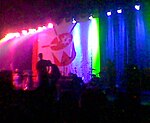Brett Whiteley House
1905 establishments in AustraliaAboriginal communities in New South WalesCommunity buildings in New South WalesFarms in New South WalesFederation style architecture ... and 10 more
Gardens in New South WalesHandicraftsHouses completed in 1905Houses in SydneyLavender BayNew South Wales State Heritage RegisterNorth Sydney CouncilParks in New South WalesRail infrastructure in New South WalesUse Australian English from February 2020

Brett Whiteley House is a heritage-listed arts and crafts studio and residence in Lavender Bay, North Sydney Council, New South Wales, Australia. It was built during 1905 by Henry Green. It is also known as Brett Whiteley House and Visual Curtilage and Lochgyle. It was added to the New South Wales State Heritage Register on 23 March 2018.
Excerpt from the Wikipedia article Brett Whiteley House (License: CC BY-SA 3.0, Authors, Images).Brett Whiteley House
Lavender Street, Sydney Lavender Bay
Geographical coordinates (GPS) Address Nearby Places Show on map
Geographical coordinates (GPS)
| Latitude | Longitude |
|---|---|
| N -33.8439 ° | E 151.2085 ° |
Address
Wendy Whiteley's Garden (Wendy's Secret Garden)
Lavender Street
2060 Sydney, Lavender Bay
New South Wales, Australia
Open on Google Maps










